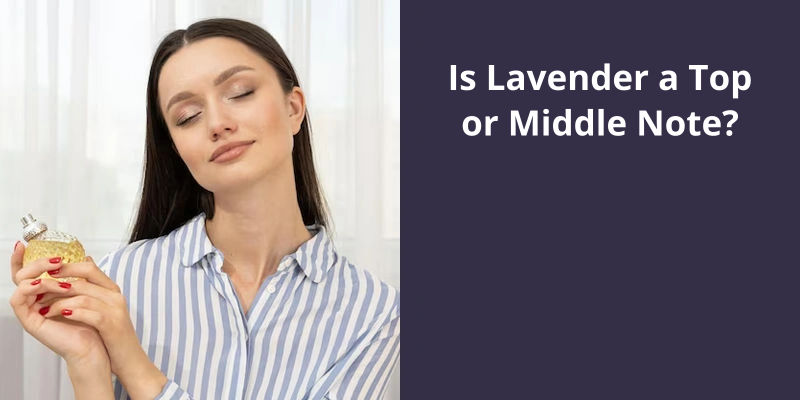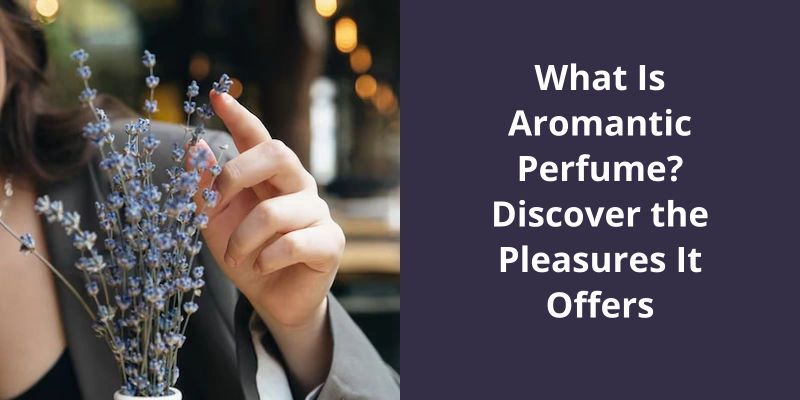Lavender, which is greatly appreciated in perfumery, typically serves as a middle note in fragrance compositions. Although it possesses a refreshing and clean scent that can be initially prominent, it’s not as fleeting as top note scents, and it doesn’t last as long as base notes. Hence, it perfectly fits the profile of middle notes, also known as heart notes, that represent the core character of a fragrance. They are more mellow and rounded, holding the scent together and being fully appreciated once the top notes have evaporated.

What Scents Are Top Notes?
When it comes to fragrance, top notes play a crucial role in capturing our attention and creating that all-important first impression. So, what scents are considered top notes? Well, they’re often characterized by their fresh and invigorating qualities. Citrus elements like bergamot, lemon, and orange zest make popular choices for top notes, as their zesty and uplifting aromas help grab our attention right from the start.
In addition to citrus, light fruits also make great top notes. Anise, berries, and grapefruit are frequently used to add a touch of sweetness to the fragrance, creating a pleasant and enticing aroma. These fruity notes can provide a burst of energy and joy that instantly captivates the senses.
Fresh herbs, such as basil, sage, and lavender, are also common top notes. These natural and aromatic elements contribute to the uplifting and invigorating qualities of a fragrance. Lavender, in particular, exudes a crisp and soothing scent that’s often associated with relaxation and tranquility.
It’s worth noting that while lavender can be considered a top note, it’s also commonly used as a middle note in many fragrances. As a middle note, lavender adds depth and complexity to the overall scent composition. It blends seamlessly with other ingredients and helps to anchor the fragrance, ensuring it’s longevity and balance.
The Difference Between Top Notes, Middle Notes, and Base Notes in Fragrance Compositions
When it comes to fragrance compositions, top notes, middle notes, and base notes play crucial roles in creating a well-balanced scent. Top notes are the first to be detected when you apply a fragrance, typically lasting for a short period. They provide the initial impression and can include light, refreshing, and citrusy scents.
On the other hand, middle notes, also known as heart notes, emerge after the top notes evaporate. They form the main body of the fragrance and are responsible for it’s character. Middle notes are usually floral, fruity, or herbal, adding depth and complexity to the scent.
Finally, base notes are the foundation of a fragrance. They’re the longest lasting and can still be detected hours after application. Base notes are often warm, rich, and sensual, providing depth and stability to the overall composition. They’re usually derived from ingredients such as woods, musks, or vanilla.
So, is lavender a top or middle note? Lavender can actually be used in both roles, depending on the fragrance composition. It’s a unique versatility that allows it to serve as a refreshing top note or a soothing middle note, adding a touch of elegance and calmness to the scent.
Moving on to the middle notes, these play a vital role in the overall aroma profile of an oil or blend. They’re the heart or body of the scent and can linger on your skin for a substantial amount of time. Among the commonly used middle note oils are clary sage, geranium, tea tree, and juniper. These oils provide a rich and balanced aromatic experience, adding depth and character to the overall fragrance.
What Oils Are Middle Notes?
Middle notes are the heart of an essential oil or blend. They create the foundation and body of the aroma, providing depth and complexity. These notes are often described as warm, rich, and full-bodied. When you inhale an essential oil, the middle notes are what you’ll notice first and they give a lasting impression.
Clary sage is a popular middle note essential oil known for it’s herbaceous and slightly sweet aroma. It’s a calming effect on the mind and body, making it a great choice for relaxation and stress relief. Geranium, on the other hand, has a floral scent that’s balancing and uplifting. It’s often used in skincare and beauty products for it’s skin-regenerating properties.
Tea tree is another middle note essential oil that’s widely recognized for it’s antiseptic and medicinal qualities. It’s a fresh, camphor-like scent that’s invigorating and cleansing. Juniper, with it’s woody and balsamic fragrance, is also a popular middle note oil known for it’s detoxifying and purifying properties.
Lavender is considered a middle note essential oil. It’s a floral and herbaceous aroma that’s soothing and calming. It’s versatile nature allows it to be used in a variety of applications, making it a popular choice among essential oil enthusiasts. So, if youre looking to add some balance and depth to your blends, lavender is definitely a top choice!
Middle Note Oils for Emotional Support and Mood Enhancement
- Lavender oil
- Chamomile oil
- Bergamot oil
- Ylang Ylang oil
- Sandalwood oil
- Clary Sage oil
- Neroli oil
- Jasmine oil
When it comes to categorizing fragrances, lavender often falls under the category of top notes. Alongside scents like sage, light fruits, ginger, and citrus, lavender is known for it’s refreshing and uplifting properties. With a relatively short lifespan of a couple of hours, top notes are specifically designed to evaporate, making them typically lighter in composition.
Is Lavender a Top Note?
Lavender is typically classified as a middle note in perfumery. Middle notes, also known as heart notes, are the aromas that make up the body of a fragrance and provide the main character and theme. They’re responsible for creating the overall balance and harmony in a perfume composition.
It blends well with other middle and base notes, adding depth and complexity to a fragrance.
These ingredients work together to create a well-rounded and harmonious scent profile.
As a middle note, lavender typically lasts longer than top notes but not as long as base notes. It can linger on the skin for several hours before gradually fading away. This makes it a valuable ingredient in perfumes, as it provides both initial freshness and lasting power.
It’s worth noting that the classification of a specific note can vary depending on the fragrance and the perfumers interpretation.
It’s versatile and complex scent profile makes it an essential ingredient in many fragrances, providing both initial freshness and long-lasting character.
Common Base Notes That Pair Well With Lavender in Perfumery
- Bergamot
- Lemon
- Lime
- Orange
- Grapefruit
- Peppermint
- Eucalyptus
- Rosemary
- Clary sage
- Geranium
- Jasmine
- Sandalwood
- Vanilla
- Ylang-ylang
- Patchouli
- Vetiver
As the scent of a perfume evolves over time, it’s the bottom notes that add depth and longevity to the fragrance. Known for their richness and warmth, these notes penetrate the skin, leaving a lingering and memorable aroma. Vanilla, powdery musk, and woody accents like sandalwood, cedarwood, and patchouli are among the popular choices when it comes to creating the perfect bottom notes for a perfume.
What Scents Are Bottom Notes?
Bottom notes in fragrance refer to the base ingredients that give a perfume it’s longevity and depth. These scents are often rich, darker, and warmer, evoking a sense of comfort and sensuality. One popular bottom note is vanilla, which adds a subtle sweetness and creaminess to the overall composition. It’s warm and comforting aroma lingers on the skin, creating a lasting impression.
Another common bottom note is powdery musk. Musk is a complex scent that can be both animalic and sensual. It’s powdery undertones add a velvety softness to the fragrance, creating a smooth and inviting aura. When combined with other ingredients, it helps to anchor the perfume and give it a long-lasting effect.
Woody accents such as sandalwood, cedarwood, and patchouli are also frequently used as bottom notes. These ingredients add depth, warmth, and an earthy quality to the overall fragrance. Sandalwood imparts a creamy and smooth aroma, while cedarwood provides a woody and aromatic quality. Patchouli, on the other hand, adds a rich and intoxicating earthiness that’s often associated with exotic and mysterious scents.
Lavender, known for it’s aromatic and powerful scent, has the ability to transport us to southern gardens, evoking a sense of summer and sometimes a touch of nostalgia. With it’s herbaceous and medicinal qualities, it adds a touch of vintage charm reminiscent of classic eau de Colognes. The fresh and invigorating fragrance of lavender incorporates hints of bergamot, subtle floral notes, and a touch of woody tones, creating a truly captivating olfactory experience.
What Scent Note Is Lavender?
Lavender is often considered a top note in many fragrances. This means that it’s one of the first scents that people notice when they apply a fragrance, and it typically fades relatively quickly. However, it can also be used as a middle note, adding depth and complexity to a scent.
In terms of it’s olfactory description, lavender is known for it’s distinctive aroma that evokes images of sunny southern gardens. It’s a powerful and aromatic scent that’s reminiscent of warm summer days. Additionally, it can sometimes have a vintage feel, bringing to mind classic eau de Colognes.
The scent of lavender is also described as herbaceous, with hints of camphor and medicinal qualities. It’s a fresh and clean aroma, which includes notes of bergamot and a subtle floral undertone. Additionally, there are woody tones present in lavender, which add depth and complexity to the overall scent profile.
It’s powerful and aromatic nature adds a refreshing and invigorating quality to a scent, while also bringing a touch of elegance and sophistication.
History and Origins of Lavender as a Scent
Lavender has a rich history as a popular scent that can be traced back thousands of years. It’s origins can be found in the Mediterranean region and the Middle East, where it was first cultivated by ancient civilizations such as the Egyptians and the Romans.
In ancient Egypt, lavender was used in the embalming process and as a perfume. The Romans, on the other hand, valued lavender for it’s medicinal properties and used it to scent their baths and clothing.
During the Middle Ages, lavender became popular in Europe for it’s fragrance and was used as a natural air freshener and insect repellent. It was also commonly used in personal hygiene practices, such as bathing and washing clothes.
Today, lavender is still highly regarded for it’s soothing and calming properties. It’s often used in aromatherapy to promote relaxation and relieve stress. Lavender essential oil, extracted from the flowers of the lavender plant, is a popular ingredient in perfumes, soaps, and household cleaners.
As a fragrance note, lavender is considered a versatile scent that can be used in various fragrance compositions. It’s often used as a middle note, adding a floral and herbaceous aroma to fragrances. However, it can also be classified as a top note in certain blends, where it’s fresh and light scent is more prominent.
Overall, lavender has a long and storied past as a scent, and it’s popularity and versatility continue to make it a sought-after fragrance ingredient in the present day.
Conclusion
It’s numerous benefits range from aiding in stress reduction to promoting restful sleep and evoking a sense of tranquility.





